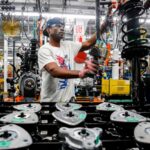By Evgenia Filimianova
AstraZeneca said on Tuesday it plans to invest $50 billion in the United States by 2030, funding a new multibillion-dollar manufacturing facility in Virginia and expanding research, development, and cell therapy operations in Maryland, Massachusetts, California, Indiana, and Texas.
The Virginia site will manufacture drug substances for weight management and metabolic treatments, including oral GLP-1 drugs, baxdrostat, oral PCSK9 inhibitors, and combination therapies. The plant will produce small molecules, peptides, and oligonucleotides, AstraZeneca said.
AstraZeneca expects the move to help drive annual revenue to $80 billion by 2030, with half of that generated in the United States, its largest market, accounting for 42 percent of total sales.
AstraZeneca’s latest commitment adds to the $3.5 billion U.S. investment it announced in November 2024.
Earlier this month, President Donald Trump said tariffs on imported drugs could rise to as much as 200 percent, starting with a low initial rate before escalating over time. The first phase is expected to take effect in August.
“We’re going to give people about a year, a year and a half, to come in, and after that, they’re going to be tariffed,” Trump said.
U.S. Commerce Secretary Howard Lutnick welcomed AstraZeneca’s decision.
“We are proud that AstraZeneca has made the decision to bring substantial pharmaceutical production to our shores,” Lutnick said. “This historic investment is bringing tens of thousands of jobs to the US and will ensure medicine sold in our country is produced right here.”
Chief Executive Officer Pascal Soriot said the company will partner with Virginia Gov. Glenn Youngkin to deliver AstraZeneca’s “largest single manufacturing investment ever.”
“It reflects the Commonwealth of Virginia’s desire to create highly skilled jobs in science and technology, and will strengthen the country’s domestic supply chain for medicines,” Soriot said.
Youngkin welcomed the investment, saying it would help secure the U.S. pharmaceutical supply chain.
Some industry groups have warned about the potential impact of tariffs on the market for affordable medicines.
The Association for Accessible Medicines, which represents generic drugmakers and biosimilar manufacturers, said in April that tariffs could worsen supply chain challenges for lower-cost treatments.
The group’s president, John Murphy III, urged the administration to work together on reforms that prioritize “patients, national security, and ultimately will lead to more resilient and reliable access” in the United States.
Investment Surge
AstraZeneca joins a growing list of pharmaceutical giants committing to large-scale investments in the United States in recent months.
On Feb. 26, Eli Lilly announced a $27 billion plan to build four new drug manufacturing sites across the country.
On March 21, Johnson & Johnson committed to more than $55 billion in U.S. investment over four years, covering manufacturing, technology, and research and development.
In April, Switzerland’s Novartis said it would spend $23 billion in the United States over five years. Roche also announced in April a $50 billion investment to expand U.S. manufacturing, a move it said would create more than 12,000 jobs. Merck unveiled plans for a $1 billion facility in Delaware.
The wave of investments comes amid policy changes aimed at boosting domestic production.
On May 5, Trump signed an executive order directing federal agencies to accelerate the development of U.S.-based pharmaceutical manufacturing.
The order calls on the Food and Drug Administration (FDA) to streamline approvals for domestic production facilities, while the Environmental Protection Agency has been tasked with speeding up construction permits for plants making prescription drugs, active pharmaceutical ingredients, and other critical materials.
The White House said the measures are intended to reduce regulatory barriers and cut the timeline for building new pharmaceutical plants.
The order also directs the FDA to increase inspections and raise fees for foreign manufacturing sites to encourage companies to shift production to the United States.





